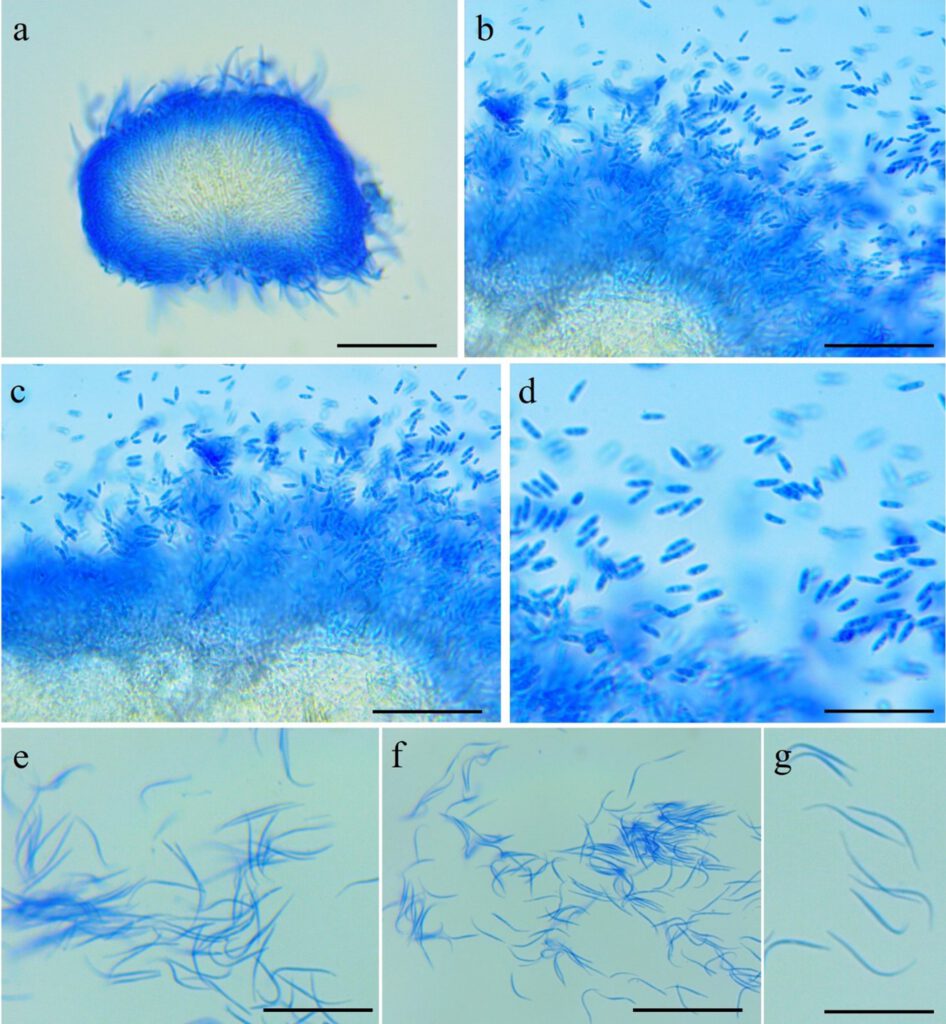Ophiocordyceps nuozhaduensis H. Yu & D.X. Tang
MycoBank number: MB; Index Fungorum number: IF; Facesoffungi number: FoF 11709;
Description
Subtropical monsoon evergreen broad-leaf forest. Camponotus sp. infected and biting the main vein of a leaf. Always at lower heights, collected from 25 cm to 50 cm above the ground. Sexual state: External mycelium was produced from the sutures and joints of the ant, producing one stroma at the head of the ant, curved at the top, cylindrical, clavate, dark brown at maturity. Fertile region of lateral cushions produced from the middle of the stroma, only one ascoma was observed, spherical, brown, averaging 2.4 × 1.6 mm. Perithecia flask-shaped, immersed to partially erumpent, with short, exposed neck or rounded ostiole, 215–285 × 128–172 μm. Asci were not observed. Ascospore vermiform, hyaline, septate, round to slightly tapered at apex, 91–132 × 2–5 µm. Asexual state: Hirsutella type-A present on the stroma. Phialides cylindrical or lageniform, smooth, swollen base, tapering abruptly a neck, short, 6–22 × 2–4 µm. Conidia ellipsoidal or oviform, 2–5 × 2–3 µm.
Material examined: CHINA, biting on leaves of the tree seedlings, 24 August 2021, H. Yu (YHH 20167, neotype).
Distribution: Puer City, Yunnan Province, China
Sequence data: LSU: ON555927 (LROR/LR5); SSU: ON555849 (NS1/NS4); EF1a: ON567769 (983F/2218R); RPB1: ON568683 (RPB1/RPB1Cr_oph).
Notes: Phylogenetically, this species was close to O. camponoti-leonardi and O. polyrhachis-furcata, it clustered in the O. unilateralis core clade of Hirsutella, with high statistical support by BI (PP = 98%) and ML (BP = 100%), formed a separate clade with O. camponoti-leonardi and O. polyrhachis-furcata (Figure 1). It was similar to sister O. camponoti-leonardi in the behavior of the host biting a leaf and perithecia rounded ostiole. However, O. nuozhaduensis was different from O. camponoti-leonardi in only producing one fertile region of lateral cushions in middle of the stroma, ascospore vermiform, conidia ellipsoidal or oviform. Moreover, the size of perithecia, ascospore, phialides and conidia also differed from O. camponoti-leonardi.

Fig. 6. Ophiocordyceps nuozhaduensis (YHH 20167). A: Camponotus sp. infected and biting the main vein of a leaf. B: The ascoma was produced from the stroma. C: Cross-section of the ascoma showing the perithecial arrangement. D-G: Ascospores. H: Conidiogenous cells and conidia. I-K: Conidiogenous cells. L-M: Conidia. Scale bars: A = 3000 µm; B = 1000 µm; C = 100 µm; D-G = 20 µm; H = 5 µm; I-K = 10 µm; L-M = 2 µm.
